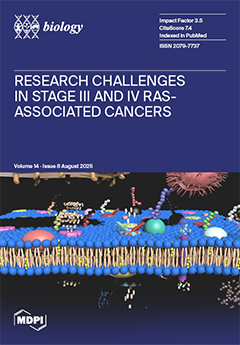Echinostomatidae is a taxonomically complex group with substantial species diversity and richness. The vast majority of species in this family parasitize birds and mammals, including humans, causing significant economic losses and medical costs. In this study,
Echinostoma miyagawai (Digenea, Echinostomatidae) and
Patagifer bilobus (Digenea, Echinostomatidae) were isolated from domestic duck and
Grus japonensis, respectively. The nearly complete ribosomal transcription unit (rTU) sequences of two echinostomes were obtained, with the rTU for
P.
bilobus being obtained for the first time. The nearly complete rTU sequence of
P.
bilobus (6790 bp) and
E.
miyagawai (6893 bp) encompass the small-subunit (18S) ribosomal DNA (rDNA), internal transcribed spacer 1 (ITS1), 5.8S rDNA, internal transcribed spacer 2 (ITS2), and large-subunit (28S) rDNA. The complete lengths of 18S, ITS1, 5.8S, ITS2, and 28S sequences for
E.
miyagawai are 1989 bp, 444 bp, 162 bp, 431 bp, and 3858 bp, respectively. For
P.
bilobus, complete or nearly complete lengths of these sequences are 1929 bp (nearly complete), 419 bp, 162 bp, 432 bp, and 3848 bp (nearly complete), respectively. The 18S, ITS, and 28S sequences of
E.
miyagawai show the highest sequence similarity with other
E.
miyagawai. The ITS and 28S sequences of
P.
bilobus show the highest sequence similarity with other
P.
bilobus, while 18S sequence shows the highest similarity with
E.
miyagawai. This is likely due to the unavailability of the 18S sequence of
P.
bilobus in GenBank. Repeat sequences were identified in 18S, ITS1, ITS2, and 28S sequences, with the 28S sequence containing the most repeats and the 5.8S sequence having none. The results of phylogenetic reconstruction indicated that
E.
miyagawai clusters with other
Echinostoma spp., while
P.
bilobus clusters with other
Patagifer spp., forming sister taxa. This study not only provides the first rTU sequence for
P.
bilobus but also reinforces the sister group status of
Patagifer to
Echinostoma through phylogenetic evidence. Finally, this study represents the first record of the
G.
japonensis as a new host for
P.
bilobus and the first report of a bird from the crane family (Gruidae) as a host for any echinostome species. These findings are significant as they expand our understanding of the host range and ecological interactions of Echinostomatidae. The data obtained provide a valuable resource of molecular markers for studying the taxonomy, population genetics, and systematics of the family Echinostomatoidea. This research contributes to a more comprehensive understanding of the evolutionary relationships and biodiversity within this complex group of parasites, which is crucial for developing effective strategies to mitigate their impact on both wildlife and human health.
Full article






